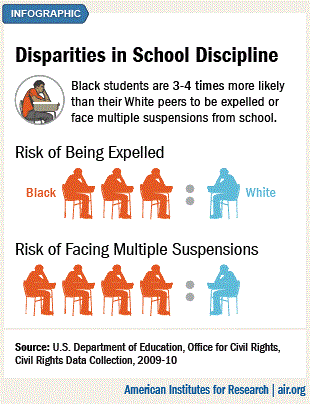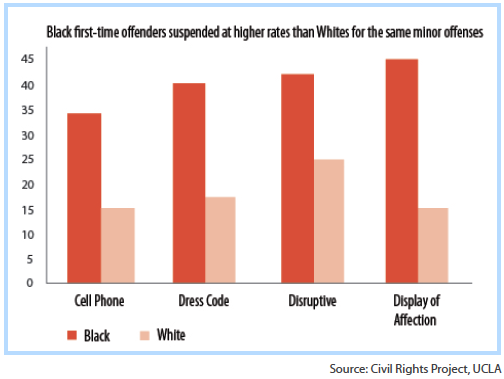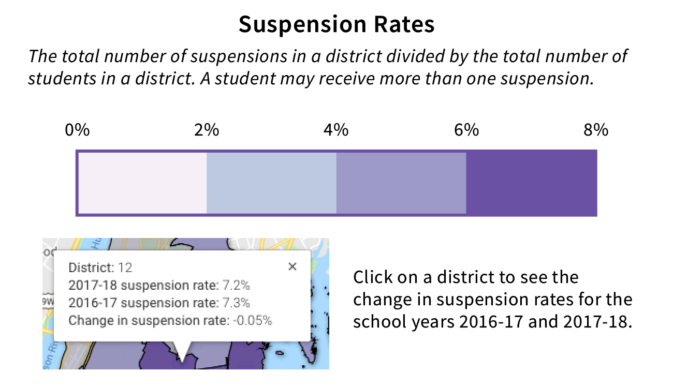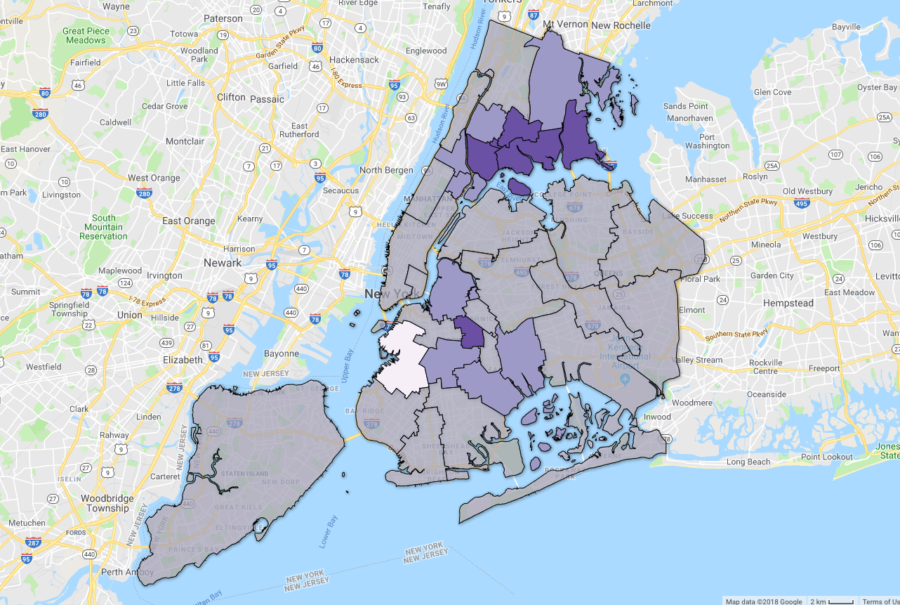by Gabby Obregon
Identifying the Problem
Black students are suspended four times more often than white students, creating an environment of criminalization rather than nurturing and restoration. Although statistics demonstrate glaring racial disparities within New York City public schools, policymakers continue to ignore the reality that black students are disproportionately excluded from classrooms leading to academic failure and entry into the criminal justice system.

Source: “School Discipline”. American Institute for Research. air.org
According to the “Disciplinary Responses” section of the Citywide Behavioral Expectations To Support Student Learning of the NYC Department of Education, discipline responses should be progressive. This is oxymoronic because the archaic, punitive practice of suspensions remains a widespread method of punishment throughout NYC schools. Children can be suspended for up to a full school year under special “superintendent’s suspensions”, and the criteria of behaviors that warrant suspension have been left to the discretion of individual teachers and administrators, increasing the achievement gap between white students and black students outside of the classroom.

Farnel Maxine details that Zero Tolerance policies began to be instituted in 1994 when the Federal Government passed legislation to expel students who brought firearms to school or lose federal funding. An unintended negative consequence of the policy was suspensions for minor infractions such as cursing in school. With black students being suspended at four times the rate as white students, the negative outcomes such as early dropout rates and school to prison pipelines demonstrated that these policies legitimized racialized criminalization in the school system.
How Suspension Affects New York City Schools
In affluent schools, teachers and administrators aim to maintain an environment to benefit the students they believe deserve to succeed: the white students. Through suspension, teachers and administrators target black students instead of proposing solutions to unacceptable behavior. However, this problem is not exclusive to desegregated schools, the number of suspensions does not differ in schools serving mostly minority students. These schools have less funding and therefore hire less skilled teachers as well as lack valuable resources. It is also essential to consider that black students experience extenuating factors such as institutional racism that contributes to infractions leading to suspension. Shortsighted policies fueled by political gains are omnipresent in the proliferating of zero tolerance policies in all schools. Ann Ferguson, in her book Bad Boys, establishes the point that “school labeling practices and the exercise of rules operated as part of a hidden curriculum to marginalize and isolate black male youth in disciplinary spaces and brand them as criminally inclined” (2). These labeling practices in New York City Schools have influenced the amount of suspensions given to black youth, with black males being the target.
As portrayed in Ferguson’s book, “judgment and sentence had been passed on [this child] so matter-of-factly by a member of the school staff” (11). Rather than nurturing children and helping them grow, teachers and administrators weed out the students considered a threat to the education of white students and categorize them as troublemakers. According to an article found in Chalkbeat, “‘superintendent suspensions,’ which are issued for more serious infractions and can run from six days through the whole school year, were handed out more than 10,000 times” and “were heavily slanted toward students of color”.
When reviewing a data map in a separate article by Alex Zimmerman that breaks down suspensions of students based on the neighborhoods they come from, the results support this hidden anti-black youth sentiment. According to the data map, District 12 in the Bronx had the highest number of students suspended, with ninety-four percent of the students in the district being black and Hispanic. With this data point alone, it is apparent how stark the differences are when determining who receives suspensions and who does not. Suspensions are an acceptable systematic tactic of racism within school systems because it is written into the curriculum. According to a New York Times article by Susan Dominus, “Suspensions do not deter bad behavior…but most likely feed it by alienating students from the school community”. Administrators perpetuate the alienation of black youth by continuing to utilize suspensions are solutions for behavior.

Source: Zimmerman, Alex. “This map shows how student suspensions in New York City are sharply divided by neighborhood”. Chalkbeat.

Source: Zimmerman, Alex. “This map shows how student suspensions in New York City are sharply divided by neighborhood”. Chalkbeat.
How NYC Schools Can Help, Rather than Harm
New York City administrators are hesitant to change the written discipline codes because they believe more “chaotic environments” are created without them. However, the chaos is created when students’ education is repeatedly disrupted because they are being forced out of their learning environments on a consistent basis and left unsupported by the proper staff. Rather than implementing structural changes and resources for punishment that have an impact on students’ behavior, administrators are struggling to let go of practices that are foundational to the environment facilitated with in an institution. Fortunately, change is beginning to take place albeit slowly. Parents and teachers are banding together to challenge antiquated and racist suspension practices by demanding they be reformed or abolished. They are pressuring figures within the larger NYC education administration to change the written policies that allow for discretion of what warrants suspensions, as well as place a cap on the length of suspensions. It is important for administrators to see that suspension is not a solution. Rather than handle students’ behavior with avoidant tactics, administrators should: develop policies on the state and local level that would end proliferation of security and police presence, reallocate the funds to hiring additional support staff such as social workers, school psychologists, and other resource staff, and ultimately implement school policies to encourage a more tolerant nurturing environment.
It is essential for parents and teachers to keep denouncing suspensions and pressuring administrators to change zero tolerance policies. The evidence from sources such as Dominus’s article proves that suspension does not positively impact students’ behavior in the ways that administrators believe. The practice of suspension only benefits the hidden curriculum of institutions that aim to categorize certain students as a problem and a threat to the education of white students. The achievement gap between white students and black students within schools cannot be rectified until more support staff is hired and the Department of Education is forced to rewrite the archaic policies of suspension.
